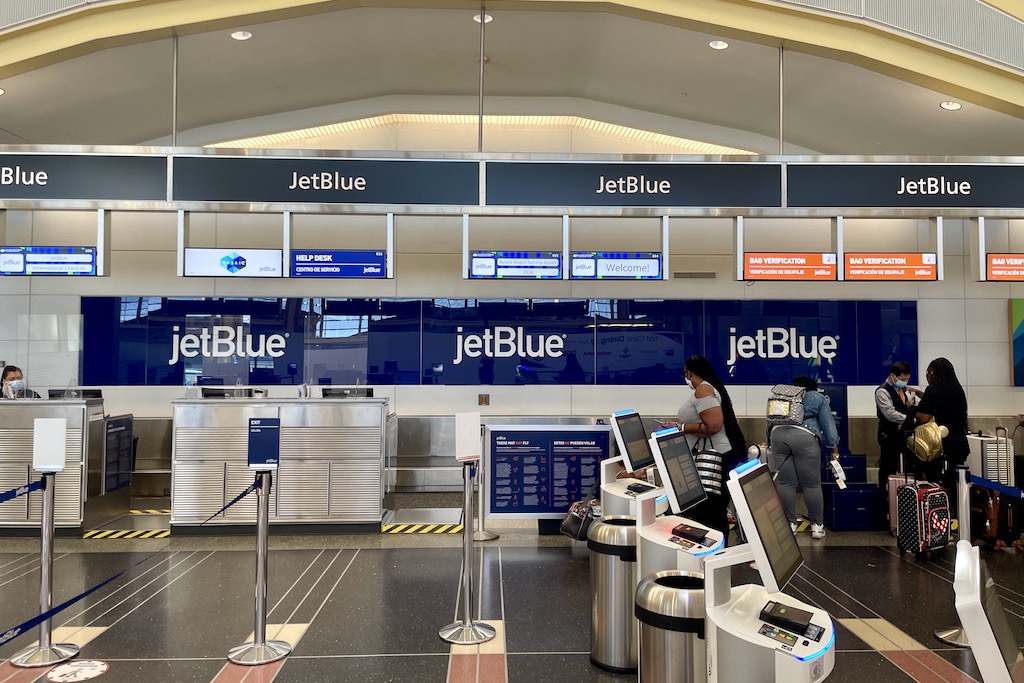JetBlue, Alaska Airlines Cut Flights as Summer Staffing Concerns Loom

Photo Credit: JetBlue ticket counter at Washington Reagan National Airport in September 2021. Airline Weekly / Edward Russell
JetBlue Airways is the latest airlines to pull back planned schedules as the combination of staffing issues and bad weather limit its ability to recover from operational disruptions.
The New York-based carrier told staff on April 8 that it would reduce capacity by 8-10 percent through the end of May in order to mitigate the impact of weather and air traffic control disruptions, CNBC reported and confirmed by the airline. "You can expect to see a similar size capacity pull for the remainder of the summer," said JetBlue President Joanna Geraghty in a memo. The move followed the cancellation of more than 300 flights over the weekend.
JetBlue's capacity cut through the end of May includes previously announced cuts of 6-8 percent, and only represents an incremental 2-4 percentage points, Wall Street analysts noted.
The news followed Alaska Airlines decision to reduce its schedule by 2 percent through the end of June. The airline cited a pilot-training backlog and shortage of cockpit crew. The Seattle-based carrier has also suffered by operational difficulties in recent weeks that it attributed to staffing, which Alaska's pilots union has denied and called a negotiating tactic by airline management.
The schedule cuts come as U.S. airlines forecast strong demand and full flights for the peak summer travel season. Leisure travelers have returned in force. Corporate flyers, for the most part, have sat on the sidelines of the recovery but are expected to come back in larger numbers than they have since the pandemic began. The combination of robust demand and fewer flights — industrywide schedules have yet to return to 2019 levels — will translate into higher fares for travelers, and improved yields for airlines.
"Airlines are still operating on razor-thin margins, and hiring/training has been an ongoing obstacle," MKM Partners analyst Conor Cunningham wrote in a note to investors on April 11. "Last summer there were several operational meltdowns during surging demand times. Erratic weather patterns are generally the start and then staffing snowballs the issues. Managements are all hyper-aware of this situation and are desperate to avoid it given the ripple effect through the network."
Pruning schedules also benefits airlines as they navigate elevated oil prices. Brent crude, the benchmark for global oil, stood at $98.20 per barrel midday on April 11, according to Bloomberg. That's down from a peak of $129.02 per barrel on March 7 but still up more than a quarter since the beginning of the year.
The staffing at U.S. airlines is the most worrisome when it comes to summer schedules. The Big 4 — American Airlines, Delta Air Lines, Southwest Airlines, and United Airlines — already have cut flights this spring due to trained staff shortages both in their ranks and those of their regional affiliates. On April 5, Southwest said it would slow pilot hiring due to a shortage in flight instructors, though the carrier did not indicate whether that would force it to cut summer schedules more than it already has.
U.S. domestic passenger capacity is gradually falling for the peak three-month June-August period compared with 2019, Cirium schedule data show. Capacity is scheduled as flat this week, which is down from up 1 percent a week ago. And capacity has been trending down since airline executives provided guidance updates for the summer in March.
"The current environment in the U.S. is unique in that capacity is artificially constrained due to labor supply issues (notably pilot training bottlenecks) and aircraft delivery delays versus robust demand," wrote Raymond James analyst Savanthi Syth on April 3.
Syth said further "cuts will likely continue through the summer" in order to mitigate operational issues. However, she doubts that they will be as deep as the up to 10 percent that JetBlue plans in May.
Airlines and flight schools are racing to start new programs and offer financial aid to increase the supply of pilots in the U.S. However, the process, which includes the requirement that all commercial airline pilots have 1,500 hours in the cockpit, takes time, and these initiatives are not expected to begin paying off for several years.
Airline executives have warned that the current U.S. pilot supply constraints are likely to continue until the middle of 2023.
Updated with context on JetBlue's previously announced spring capacity cuts.
